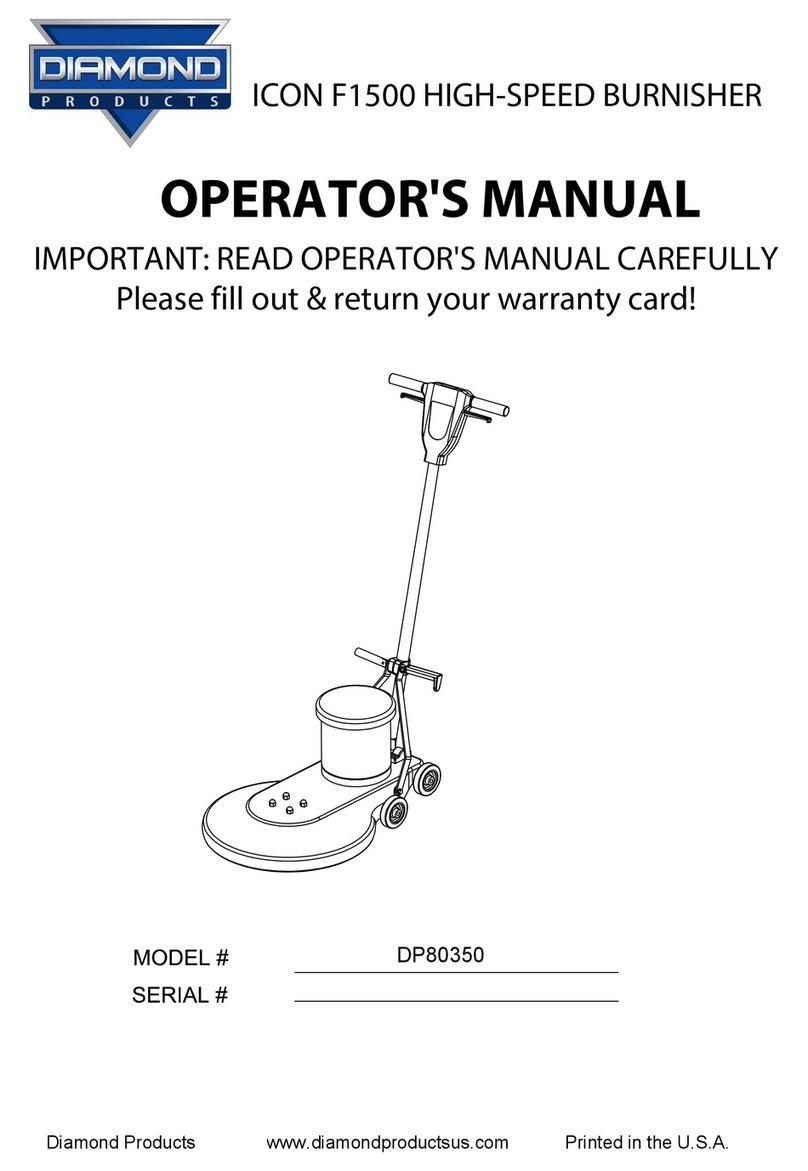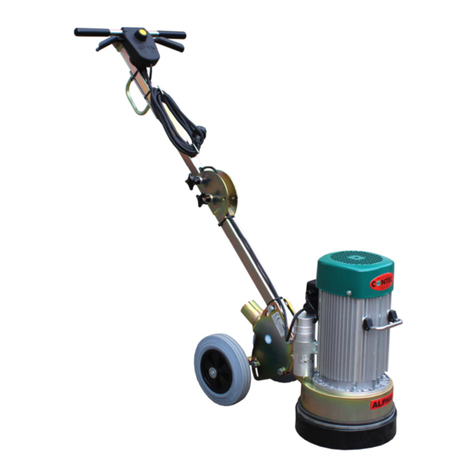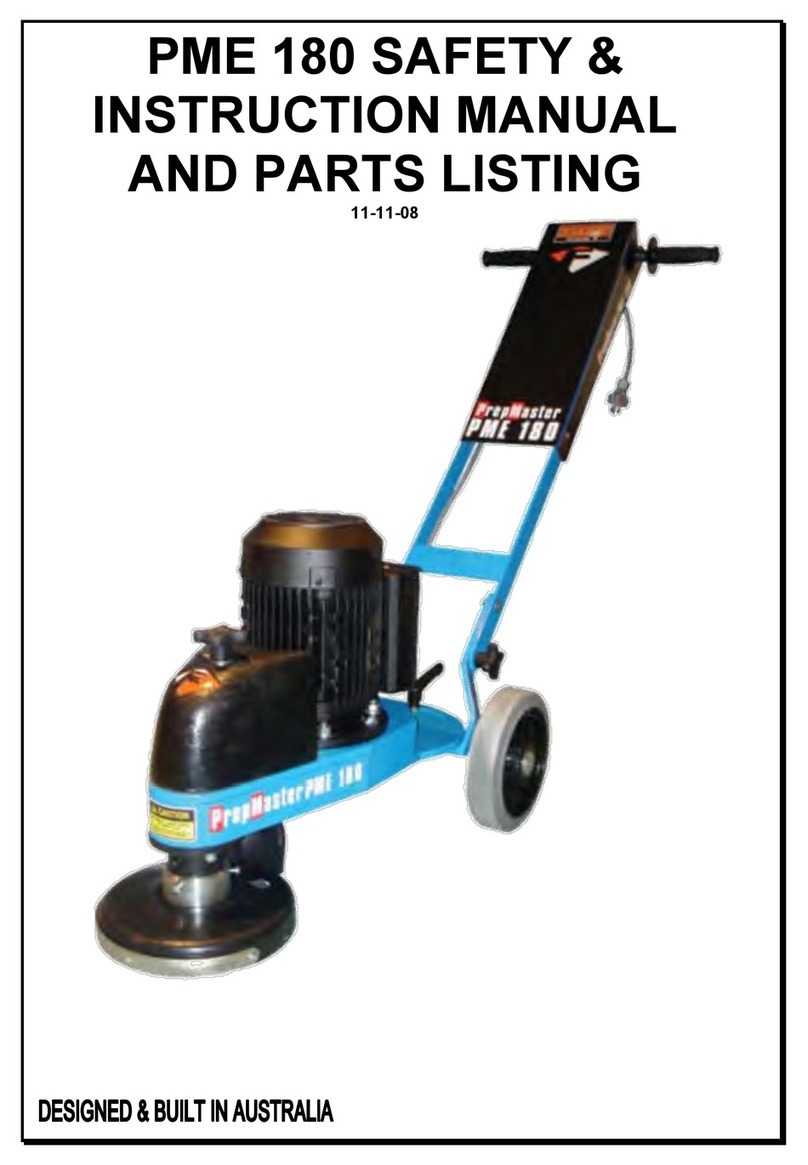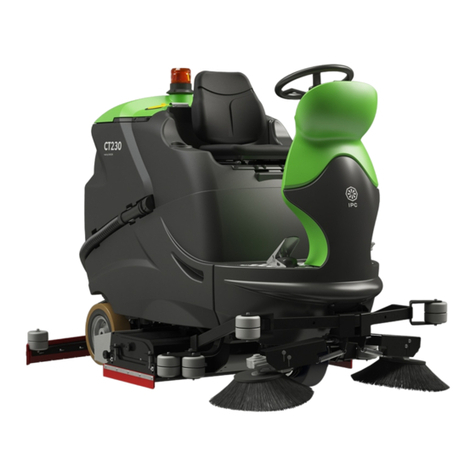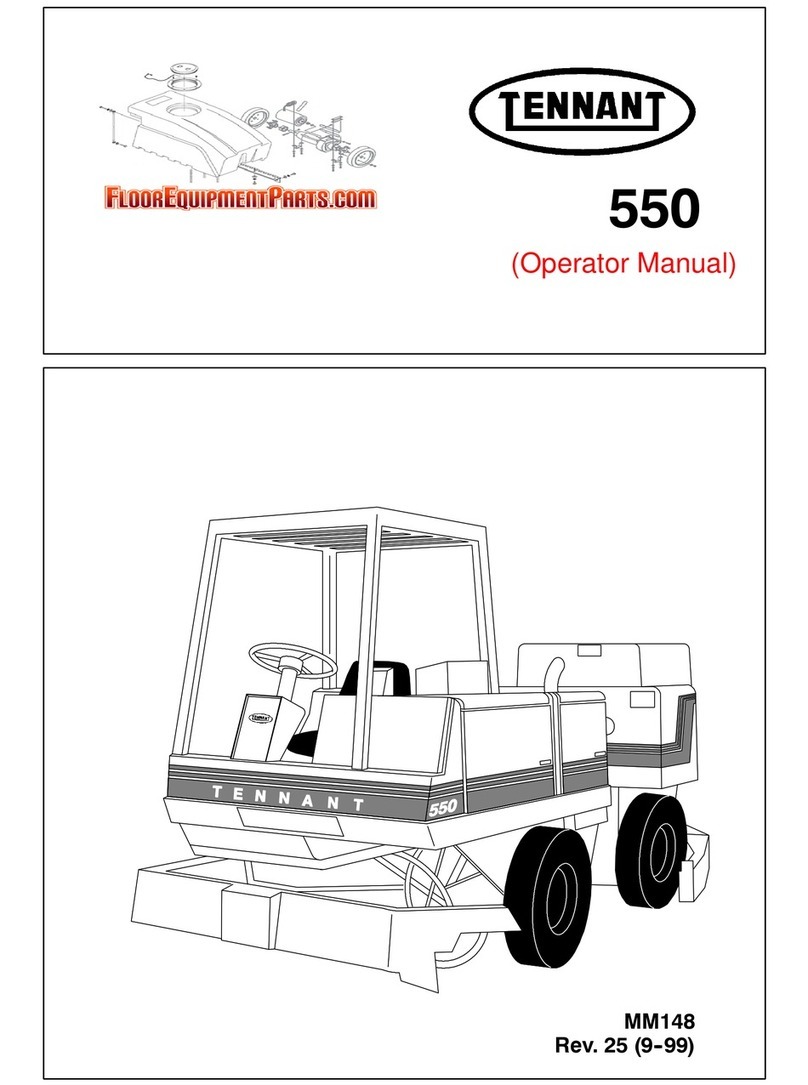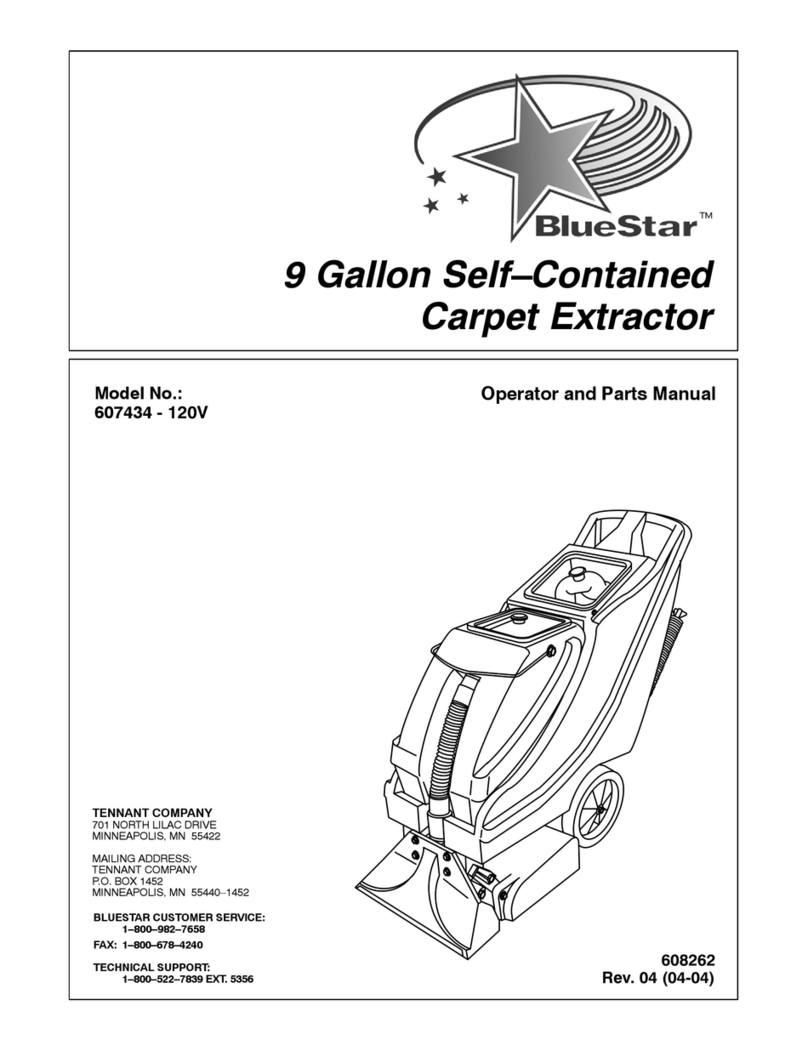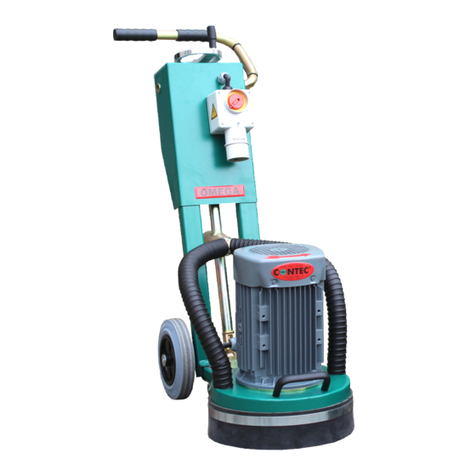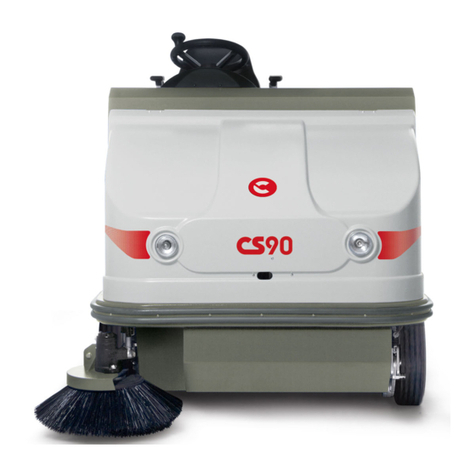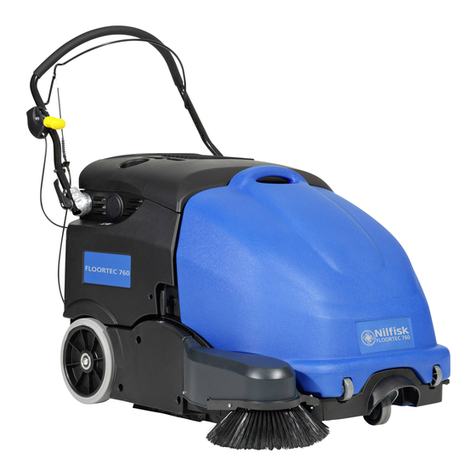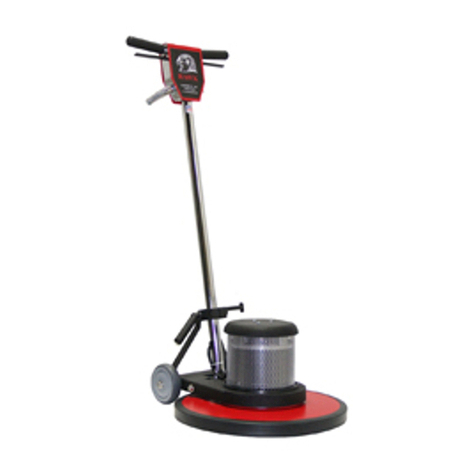Diamond Products CPG80E User manual

FLOOR GRINDER
OPERATOR’S MANUAL
CPG80E
Low Profile Floor Grinder
October, 2019
Part #: 1802708


TABLE OF CONTENTS
Table of Contents
Introduction ............................................................................................................................................. 5
CPG80E Components ............................................................................................................................ 6
CPG80E Dimensions .............................................................................................................................. 7
CPG80E Specifications .......................................................................................................................... 8
Safety ..................................................................................................................................................... 9
Safety Alerts ........................................................................................................................................ 9
Proposition 65 ..................................................................................................................................... 9
Respiratory Hazards ........................................................................................................................... 9
General Safety .................................................................................................................................. 10
Grinding Safety ................................................................................................................................. 11
Belt Safety ......................................................................................................................................... 11
Transporting Safety ........................................................................................................................... 11
Lifting Safety ..................................................................................................................................... 11
Operating .............................................................................................................................................. 12
General Operating Precautions ......................................................................................................... 12
Handlebar .......................................................................................................................................... 12
Handlebar ...................................................................................................................................... 12
Adjusting the Handlebar ................................................................................................................ 12
Diamond Grinding Head .................................................................................................................... 12
Inspecting the Grinding Head ........................................................................................................ 12
Installing the Grinding Head .......................................................................................................... 13
Removing the Grinding Head ........................................................................................................ 13
Motor ................................................................................................................................................. 14
Starting the Motor .......................................................................................................................... 14
Stopping the Motor ........................................................................................................................ 14
Vacuum Port ..................................................................................................................................... 14
Water Supply ..................................................................................................................................... 14
Grinding ............................................................................................................................................. 15
Tasks Prior to Grinding .................................................................................................................. 15
Dry Grinding .................................................................................................................................. 15
Wet Grinding.................................................................................................................................. 15
Edging ............................................................................................................................................... 16
Edge Grinding Adjustments ........................................................................................................... 16
Maintenance ......................................................................................................................................... 17
General ............................................................................................................................................. 17
Pre Maintenance Preparations .......................................................................................................... 17
General Cleaning .............................................................................................................................. 17
Cleaning Techniques ..................................................................................................................... 17
Starter Switch Control Box ............................................................................................................ 17
Motor ............................................................................................................................................. 17
Part Lubrication ................................................................................................................................. 17
Post Cleaning .................................................................................................................................... 17
Service Schedule .................................................................................................................................. 18
Daily Service ......................................................................................................................................... 19
Handlebar .......................................................................................................................................... 19
Lubricate the Blade Shaft Bearings ................................................................................................... 19
Inspect the Drive Belt ........................................................................................................................ 19
Drive Belt Access .......................................................................................................................... 19

TABLE OF CONTENTS
Belt Tensioning ................................................................................................................................. 19
Tensioning the Drive Belts............................................................................................................. 20
Replacing the Drive Belts .............................................................................................................. 20
Motor .................................................................................................................................................... 21
Disconnecting the Power to the Motor .................................................................................................. 21
Lifting .................................................................................................................................................... 21
Transport .............................................................................................................................................. 21
Prior to Transport .............................................................................................................................. 21
Transport ........................................................................................................................................... 21
Storage ................................................................................................................................................. 21
Disposal ................................................................................................................................................ 21
Appendix A ........................................................................................................................................... 23
Troubleshooting ................................................................................................................................ 23
Appendix B ........................................................................................................................................... 24
Belt Tension Specifications ............................................................................................................... 24
Power Cord Specifications ................................................................................................................ 24
Appendix C ........................................................................................................................................... 25
Additional Resources ........................................................................................................................ 25
Appendix D ........................................................................................................................................... 26
Model and Serial Numbers ................................................................................................................ 26

INTRODUCTION
Introduction
Welcome to the Diamond Products family and thank you for choosing Diamond Products equipment.
At Diamond Products we are driven to ensure you are completely satisfied with your product and
continually strive to improve our product line so that we can offer you the best possible equipment in
the industry.
This operator’s manual is a critical document that provides pertinent information regarding the safety,
operation, maintenance, and care of your new equipment. Keep this manual available at all times.
Operate the equipment and all of its components according to this manual. Failure to comply with and
understand the following safety, operation and maintenance instructions can result in serious injuries
and/or death. All operators must be properly trained or supervised by experienced personnel prior to
using this floor grinder and should understand the risks and hazards involved. Diamond Products
discourages improper or unintended equipment usage and cannot be held liable for any resulting
damages.
Equipment modifications should be made by Diamond Products to ensure safety and design. Any
modifications made by the owner(s) are not the responsibility of Diamond Products and void all
equipment warranties if a problem arises as a result of the modification.
Refer to the Diamond Products Parts List for additional information and part diagrams. Refer to the
motor manufacturer as the primary source for all safety, operations, and maintenance instructions
regarding the motor. Prior to operating, record the floor grinder’s serial number, and the motor’s model
and serial numbers in Appendix D.
5

INTRODUCTION
CPG80E Components
1. Front Guard
2. Motor
3. Motor Switchbox
4. Motor Power Plug
5. Handlebar
6. Water Supply Connection
7. Water Supply Valve
8. Handlebar Locking Pins
9. Motor Reset Button
10. Vacuum Attachment Port
11. Flex Coupling
12. Disc Mounting Plate
13. Grinding Head
6

INTRODUCTION
CPG80E Dimensions
CPG80E Dimensions Inches Millimeters
A Grinder Height – Min. (Handlebar in lower position) 37 940
Grinder Height – Max. (Handlebar in upper position) 40 1016
B Grinder Length 41 1041
C Wheel Height 8 203
D Motor Height 20-1/2 521
E Grinder Width 17-1/2 445
F Rear Axle Width 17 432
G Rear Axle to Drive Shaft Length 15-3/4 400
7

INTRODUCTION
CPG80E Specifications
Maximum Grinding Head Capacity 8”
Motor Model Baldor 35U782T988C1
Rated Output Power 2 HP
Rated Voltage 115/230 V
Rated Speed 1725 rpm (Baldor rating)
Rated Frequency 60Hz.
Phase 1
Lubrication Type NLGI #1 Lithium Synthetic grease
Grinding Head Shaft Size 1-3/4" OD
Grinding Head Shaft Bearings 1” Flange Bearing
Blade Shaft Drive Motor: 2 V-Belt (3VX315)
Rear Axle Size Rear: 1" OD pivoting
Rear Wheels 8" x 2" x 3/4" (roller ball bearings)
Handlebar Adjustment Variable extension with 19” range
8

SAFETY PRECAUTIONS
Safety
Operate the equipment and all of its
components according to this manual. Failure
to comply with and understand the following
safety, operation and maintenance instructions
can result in serious injuries and/or death. All
operators must be properly trained or
supervised by experienced personnel prior to
using this floor grinder and should understand
the risks and hazards involved. Diamond
Products discourages improper or unintended
equipment usage and cannot be held liable for
any resulting damages.
Equipment modifications should be made by
Diamond Products to ensure safety and
design. Any modifications made by the
owner(s) are not the responsibility of Diamond
Products and void all equipment warranties if a
problem arises as a result of the modification.
Refer to the Diamond Products Parts List for
additional information and part diagrams. Refer
to the motor manufacturer as the primary
source for all safety, operations, and
maintenance instructions regarding the motor.
Prior to operating, record the floor grinder’s
serial number, and the motor’s model and
serial numbers in Appendix D.
Notice: The information in this manual may
be updated at any time!
Safety Alerts
DANGER
Serious injuries and/or death will occur if
these instructions are not followed.
WARNING
Serious injuries and/or death could occur if
these instructions are not followed.
CAUTION
Mild and/or moderate injuries could occur if
these instructions are not followed.
Proposition 65
PROPOSITION 65
WARNING: Concrete cutting
produces dust that can expose
you to chemicals including
Silica, crystalline (airborne
particles of respirable size),
which is known to the state of
California to cause cancer. For
more information go to:
WWW.P65WARNINGS.CA.GOV
Respiratory Hazards
WARNING
Concrete cutting produces dust and fumes
known to cause illness, death, respiratory
disease, birth defects, and/or other
reproductive harm. Safety protection
techniques include, but are not limited to:
• Wearing gloves.
• Wearing safety goggles or a face
shield.
• Using approved respirators.
• Washing work clothes daily.
• Using water when wet cutting to
minimize dust.
• Washing the hands and face prior to
eating/drinking.
For additional safety and self-protection
information contact your employer, the
Occupational Safety and Health
Administration (OSHA), and/or The National
Institute for Occupational Safety and Health
(NIOSH).
9

SAFETY PRECAUTIONS
General Safety
• Read and understand all safety,
operations, and maintenance instructions
provided in this manual prior to operating or
servicing the floor grinder.
• Keep equipment components clean and
free of slurry, concrete dust, and debris.
• Inspect water hoses prior to operating the
equipment. Clean, repair, or replace
damaged components.
• Repair the equipment immediately when a
problem arises.
• Replace equipment decals if unreadable.
• Dispose of all hazardous waste materials
according to city, state, and federal
regulations.
• Always have a phone nearby, and locate
the nearest fire extinguisher and first aid kit
prior to operating the equipment.
• Operate the equipment wearing flame
resistant clothing.
• Underage or non-trained personnel should
not operate the equipment.
• Keep all body parts away from rotating
machinery.
• Replace all guards and access panels
(unless stated otherwise) prior to operating
the equipment.
DO NOT:
• Assume the equipment will remain still
when parking/stopping the equipment on a
slope. Chock the wheels to help prevent
unnecessary movement.
• Drop equipment, supplies, tools, etc., when
handling to help prevent injuries.
• Lift and carry equipment, supplies, tools,
etc., that are too heavy and/or cannot be
lifted easily.
• Operate the equipment without using the
appropriate safety equipment required
for the work task.
• Operate or service the equipment with any
clothing, hair, or accessories that can snag
in the machinery, which could lead to
serious injuries or death!
• Operate the equipment using attachments
not associated with or recommended for
the equipment.
• Operate the equipment around combustible
materials.
• Operate the equipment with anyone near
the work area.
• Operate the equipment until all
unnecessary materials have been removed
from the work area.
• Operate the equipment with loose nuts,
screws, and bolts.
• Operate the equipment when ill or fatigued.
• Operate the equipment under the influence
of drugs and/or alcohol.
• Operate the equipment on steep slopes.
• Grease the equipment with the motor
running.
• Touch hot components when operating the
equipment.
• Leave the equipment unattended until the
motor is off and the blade has stopped.
• Place the equipment into storage until it
has cooled down.
• Service the equipment until it has cooled
down.
• Service the equipment with the motor
running.
10

SAFETY PRECAUTIONS
Grinding Safety
• The direct work area should not contain
buried or embedded electrical, gas, or
water lines that could be damaged and/or
cause personal injury while grinding.
• Turn off all electricity, gas, and water
around the direct work area prior to
grinding.
• Inspect the work area to ensure nothing will
impede full control of the machine at all
times.
• DO NOT allow any person, animal, and/or
objects in and around the work area while
grinding.
• Ensure the work area is adequately
illuminated to ensure safe operation of the
machine.
• Disconnect power when not in use, before
servicing, and when changing the grinding
head.
Belt Safety
• Turn off the motor and let the belt cool
down prior to servicing it.
• Regularly inspect the belt for fraying, stress
cracks, and/or breakage and replace
immediately when damaged. Always check
the belt alignment prior to operating the
equipment.
• Use extreme caution when working with
belts and rotating machine parts to avoid
entanglement.
• Over-tensioning the belt may reduce the
life of the blade shaft bearings. Under-
tensioning the belt may cause slippage,
shorter belt life, and/or poor equipment
performance.
• Squealing belts indicate looseness.
Transporting Safety
• Remove the grinding head prior to
transporting the equipment.
• Chock the wheels and secure the floor
grinder in the truck/trailer prior to
transporting.
• Ensure the grinding head does not make
contact with the ground and/or other surface
when transporting the floor grinder.
• Refer to the Department of Transportation
(DOT) for additional transportation
recommendations.
Lifting Safety
• Move yourself and all others
away from the lifting area when
hoisting the floor grinder to
prevent being crushed.
• DO NOT attempt to lift the floor grinder
irresponsibly and/or improperly.
11

OPERATING
Operating
General Operating Precautions
• Prior to operating the machine, read the
operator’s manual thoroughly and ensure
that you understand the safe and proper
operation of the machine.
• Use approved personal protective
equipment at all times while operating the
machine.
• Ensure that there is firefighting equipment
and a first aid kit nearby while operating the
machine.
• Ensure the grinding area is free of
obstructions, people, and or animals prior
to operating the machine.
• Always operate the machine from the
operator’s position at the rear of the
machine.
• Ensure that the proper grinding head is
used for the application.
Handlebar
The handlebar helps the operator guide and
maneuver the floor grinder. It is important to
have the handlebar set to a comfortable
working height. There are two height settings
for the floor grinder. The lower setting will set
the handlebar at a height of 37” and the upper
setting will place it at 40”.
Handlebar
Adjusting the Handlebar
1. Pull out the two T-handle locking pins from
the handlebar support tubes.
T-Handle Locking Pins
2. Adjust the handlebar up or down to the
desired working height.
3. Align the holes in the handlebar with the
hole in the support tube and reinsert the
two T-handle locking pins into the
handlebar support tube to secure.
Diamond Grinding Head
WARNING
• DO NOT use damaged grinding heads
when grinding to avoid harming yourself,
others, or the floor grinder.
• Always use an appropriate type of
grinding head based on the type of
material being ground.
Using the proper grinding head preserves the
grinding head and improves grinding and
operator efficiency, resulting in lower costs.
Inspecting the Grinding Head
Inspect each grinding head prior to installation
and discard all damaged grinding heads.
Inspect all grinding heads for:
• Cracks, nicks, and dents
• A damaged and/or deformed arbor (center
hole)
• A deformed blade circumference
• Segment loss and/or segment cracks
• Core wear
• Bending
12

OPERATING
Installing the Grinding Head
WARNING
• DO NOT install a grinding
head with the motor running.
Failure to properly secure the grinding
head may cause parts to loosen or fall
off the saw.
CAUTION
• Wear gloves and be alert to the
surrounding environment when
handling grinding heads.
1. Pull back on the handlebar and lay the floor
grinder on the ground into the grinding
head assembly position.
Grinding Head Assembly Position
Disk Mounting Flange
2. With the disk mounting flange exposed,
place the grinding head onto the flange and
align the four bolt holes.
3. Attach the grinding head to the flange by
installing four 3/8”-16 flat head cap screws
through the grinding head into the disk
mounting flange and tighten to secure.
Grinding Head Bolts
4. Pull the floor grinder back up into the
normal operating position.
Removing the Grinding Head
CAUTION
• DO NOT remove a grinding head with
the motor running.
1. Pull back on the handlebar and lay the floor
grinder on the ground into the grinding
head assembly position.
Grinding Head Assembly Position
2. Remove the four 3/8-16” flat heat cap
screws attaching the grinding head to the
disk mounting flange
3. Pull the floor grinder back up into the
normal operating position.
13

OPERATING
Motor
The CPG80E floor grinder uses a 2 HP,
115/230 V, single phase electric motor rated at
1725 RPM.
The motor is controlled through a switch box
assembly. The switch box allows the operator
to start and stop the motor.
The motor is protected by a thermal overload.
In the event that the motor overheats, the
thermal protector circuit will open shutting the
motor off. If this occurs, turn the motor control
switch to OFF and allow the motor time to cool.
When the motor has cooled, press the reset
button located on the motor. A click indicates
that the motor is reset and can now be
restarted.
WARNING
DO NOT leave the saw unattended while the
motor is running.
Starting the Motor
1. Ensure the floor grinder is in the normal
operation, raised, position.
2. Connect the floor grinder to a power source
using a properly sized power cord in
accordance with Appendix B.
CAUTION
Use of a wire gauge that is too small will
cause loss of power or overheating and will
damage the electric motor
3. Push down on the handlebar to reduce the
pressure of the grinding head on the
ground.
4. Move the starter switch to the ON
5. Allow the motor to come up to full operating
speed.
Stopping the Motor
CAUTION
DO NOT leave the grinder unattended until
the motor is off and the grinding head
has stopped spinning.
1. Move the starter switch to the OFF
position.
2. Maintain contact between the grinding
head and the ground until the grinding
head comes to a full stop.
3. Disconnect the floor grinder from the power
source.
Vacuum Port
When dry grinding it is required to have a dust
containment system used in conjunction with
the floor grinder. A dust port is located at the
back of the grinder to attach a vacuum.
Connect the vacuum to the port using a 2 inch
(50mm) hose.
Ensure that the vacuum filters are clean prior
to use and that the rubber skirt on the front
guard is in contact with the ground at all times
during operation.
Dust Port
Water Supply
The floor grinder is equipped with a water
supply connection located on the left side of
the handlebar. The water is metered through
the water supply to the grinding head to cool
the head and minimize dust.
14

OPERATING
Water Supply Valve
Grinding
Tasks Prior to Grinding
Complete the following tasks prior to grinding
• Ensure the handlebar is securely attached
and at the desired working height.
• Inspect the grinding head and shaft for
damage and repair or replace as required.
• Make sure that the grinding head is
suitable for the job.
• Ensure there is a water source available if
wet grinding.
• Ensure there is an adequate dust collection
system available if dry grinding.
• Verify that the power cord is properly sized
for the job in accordance with Appendix B.
• Turn off all electricity, gas, and water
around the direct work area.
Dry Grinding
1. Connect a dust collecting vacuum system
to the dust port.
2. Connect the floor grinder to a power source
using a properly sized power cord in
accordance with Appendix B.
CAUTION
Use of a wire gauge that is too small will
cause loss of power or overheating and will
damage the electric motor
3. Start the dust collecting vacuum system in
accordance with the manufacturer’s
instructions.
4. Push down on the handlebar to reduce the
pressure of the grinding head on the
ground.
5. Move the starter switch to the ON position.
6. Allow the motor to come up to full operating
speed.
7. With both hands firmly on the handlebar,
move the grinder from side to side ensuring
not to stop in one spot too long as this will
lead to grooving of the surface.
8. Keep the rubber skirt on the front guard
assembly firmly on the surface to ensure
proper dust collection.
9. When the grinding is complete, move the
starter switch to the OFF position.
10. Maintain contact between the grinding
head and the ground until the grinding
head comes to a full stop.
11. Disconnect the floor grinder from the power
source.
12. Turn off the dust collecting system in
accordance with the manufacturer’s
instructions.
Wet Grinding
1. Ensure water control valve is in the shut
position and connect a water supply hose
to the inlet of the water control valve.
2. Connect the floor grinder to a power source
using a properly sized power cord in
accordance with Appendix B.
CAUTION
Use of a wire gauge that is too small will
cause loss of power or overheating and will
damage the electric motor
3. Ensure that water is available to the water
control valve and open the valve to begin
flow to the grinding head.
4. Push down on the handlebar to reduce the
pressure of the grinding head on the
ground.
5. Move the starter switch to the ON position.
6. Allow the motor to come up to full operating
speed.
15

OPERATING
7. With both hands firmly on the handlebar,
move the grinder from side to side ensuring
not to stop in one spot too long as this will
lead to grooving of the surface.
8. Keep the rubber skirt on the front guard
assembly firmly on the surface to minimize
slurry spray.
9. When the grinding is complete, move the
starter switch to the OFF position.
10. Maintain contact between the grinding
head and the ground until the grinding
head comes to a full stop.
11. Shut the water control valve.
12. Disconnect the floor grinder from the power
source.
13. Turn off the water supply and disconnect
the supply hose to the grinder.
Edging
The CPG80E low profile floor grinder has the
capability of edge grinding close to walls. The
rear axle is designed to be adjusted to allow for
both left and right hand edge grinding.
Edge Grinding Adjustments
1. On the rear axle, remove the thumb screw
from the rear axle weldment.
2. Using a 9/16” wrench, loosen the two
adjustment bolts to allow for rotation of the
rear axle.
Rear Axle Adjustment
3. For right side edge grinding, rotate the
wheels to the left.
Right Side Edge Grinding
4. For left side edge grinding, rotate the
wheels to the right.
Left Side Edge Grinding
5. When the rear axle is properly aligned,
tighten the two adjustment bolts.
6. Reinstall the thumb screw and tighten to
secure the axle in place.
7. Operate the grinder in accordance with
either the dry or wet grinding instructions
called out in this manual.
16

MAINTENANCE
Maintenance
General
Failure to read and comply with the
maintenance instructions provided in this
manual prior to performing maintenance may
result in serious injuries and/or death, and may
harm the floor grinder. DO NOT attempt to
perform maintenance on the floor grinder if you
are not properly trained for it, or are not
supervised by an experienced person.
Refer to the CPG80E Parts List for additional
information and part diagrams when
performing maintenance tasks. Refer to the
motor manufacturer as the primary source for
all safety, operations, and maintenance
instructions for the motor. Contact the floor
grinder and/or motor manufacturer with any
additional questions.
Remove all necessary guards and access
panels prior to servicing the floor grinder.
Replace prior to operating.
Pre Maintenance Preparations
• Ensure the floor grinder is in a safe area to
conduct maintenance.
• Maintain proper cleanliness of the work
area to minimize personnel injury or
equipment damage.
• Ensure the floor grinder is sufficiently cool
to conduct any maintenance.
• Remove the grinding head prior to starting
any maintenance.
• Place the floor grinder on a level surface
with the motor turned off.
• Ensure there is adequate lighting in the
work area to ensure safety.
• Ensure all equipment and tools required for
the maintenance task are staged and
available for use.
• Prior to any maintenance being performed,
know the locations of all safety equipment
such as fire extinguishers, first aid kits, etc.
• All maintenance shall be performed by
qualified personnel only.
General Cleaning
The floor grinder must be cleaned after each
use and prior to conducting any maintenance.
Ensure that the floor grinder is cool prior to
cleaning. Ensure affected electrical equipment
is properly covered or de-energized prior to
cleaning with water or air.
Cleaning Techniques
Various cleaning options can be utilized
depending on the type of cleaning required.
High pressure washers and a mild detergent
will work the best. Compressed air and low
pressure water can also be utilized where
required.
CAUTION
Care must be taken when using high
pressure water and compressed air to
conduct any maintenance or cleaning. High
pressure water and compressed air can
cause injury to personnel or damage to
equipment if not used properly.
Starter Switch Control Box
Do not spay water on the starter switch control
box to clean. Use a damp cloth or compressed
air to clean electrical components. Dry the
starter box panel after cleaning.
Motor
Use a mild detergent and water to clean the
motor. Do not to spray water forcefully on the
motor to prevent damage to components.
Part Lubrication
WARNING
DO NOT grease parts with the
motor running.
Lubricate all necessary parts on schedule for
maximum floor grinder efficiency. Use one half
to one full pump of NLGI No. 1 premium,
lithium-based grease when lubricating all
grease fittings.
Post Cleaning
• Lubricate the machine as required.
• Dry all electrical components using
compressed air.
• Do not start the machine until it has had
time to thoroughly dry.
17

MAINTENANCE
Service Schedule
The service schedule is based primarily on the standard operating time of the machine. The
frequency of the maintenance tasks can be increased based on the working environments of the
machine.
Task Cycle
Daily
Visually inspect floor grinder for damage and repair as necessary X
Wipe down and clean all components for dust and debris X
Check for loose or frayed wiring. Repair/replace as necessary X
Check for loose nuts and bolts and retighten X
Lubricate blade shaft bearings (End of work day) X
Inspect the drive belt for tension or wear and re-tension or replace
as necessary X1
1. Inspect the belt after the first four hours and then daily.
18

MAINTENANCE
Daily Service
Handlebar
The handlebar generally requires little or no
maintenance and, when used correctly, should
remain in good, working condition. Inspect the
handlebar occasionally for bending, unusual
cracks, and/or breakage. Replace it
immediately when damaged.
Lubricate the Blade Shaft Bearings
WARNING
DO NOT grease parts with the
motor running.
Lubricating the blade shaft bearings on
schedule increases the floor grinder’s
efficiency and life. Use NLGI No. 1 premium
lithium-based grease when lubricating parts.
Use one-half to one full pump of grease when
lubricating grease fittings.
At the end of each work day, lubricate the two
blade shaft bearings. Locate the upper and
lower blade shaft bearing grease fittings
located under frame base at the front of the
floor grinder. To access the lower blade shaft
bearing, pull down on the flexible hose.
1. Add no more than one pump of bearing
grease into each of the two blade shaft
bearing grease fittings.
Upper Blade Shaft Bearing Grease Fitting Access
Lower Blade Shaft Bearing Grease Fitting
(Flexible Hose Pulled Down)
Inspect the Drive Belt
Inspect the drive belt after the first four hours
of use and then daily for tension or wear. Re-
tension or replace as required.
Drive Belt Access
1. Remove the four 1/4”-20 flat head cap
screws from the pulley shield.
2. Remove the pulley shield.
Pulley Shield
Belt Tensioning
When tensioning belts, DO NOT exceed the
manufacturer’s recommended belt tension
settings as specified in Appendix B.
NOTE: Over-tensioning belts may damage the
motor. Under-tensioning belts may cause
slippage, shorter belt life, and/or poor floor
grinder performance. Squealing belts indicate
looseness.
19

MAINTENANCE
Tensioning the Drive Belts
1. Using a 9/16” wrench, loosen the four
motor mounting bolts on the motor base.
Motor Mounting Bolts
2. Using a 1/4” hex drive, turn the drive belt
tensioning bolt clockwise to tighten or
counter-clockwise to loosen the belts.
Drive Belt Tensioning Bolt
3. Tension the belts as required and retighten
the four motor mounting bolts on the motor
base.
Replacing the Drive Belts
WARNING
De-energize the power to the floor
grinder by unplugging the power
cord prior to removing V-belts
1. Remove the four 1/4”-20 flat head cap
screws from the pulley shield.
2. Remove the pulley shield.
Pulley Shield
3. Using a 9/16” wrench, loosen the four
motor mounting bolts on the motor base.
Motor Mounting Bolts
4. Using a 1/4” hex drive, turn the drive belt
tensioning bolt counter-clockwise and push
the motor forward to loosen the belts.
Drive Belt Tensioning Bolt
20
Table of contents
Other Diamond Products Floor Machine manuals
Popular Floor Machine manuals by other brands
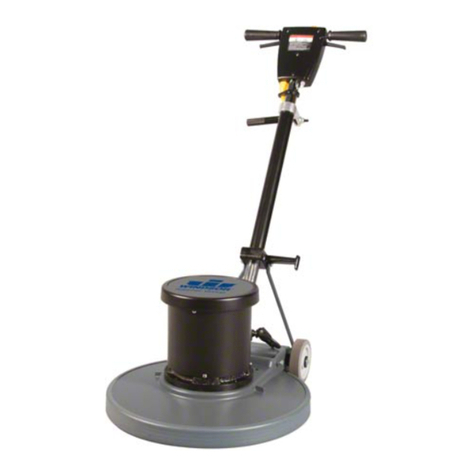
Windsor
Windsor MERIT MP13 operating instructions
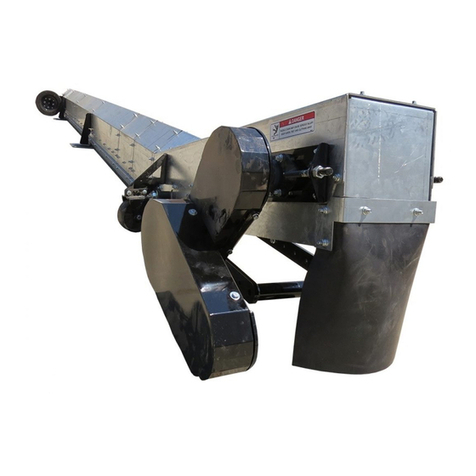
Sioux Tools
Sioux Tools DAAY POWER SWEEP owner's manual
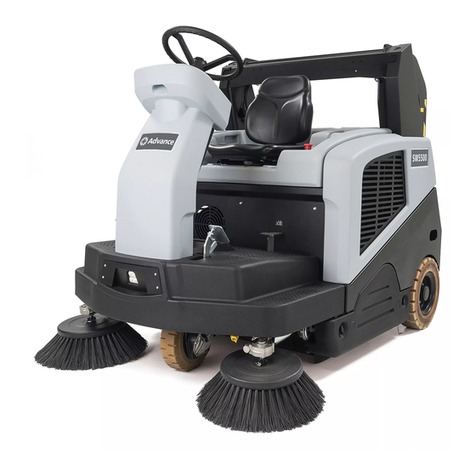
Nilfisk-Advance
Nilfisk-Advance SW5500 Instructions for use
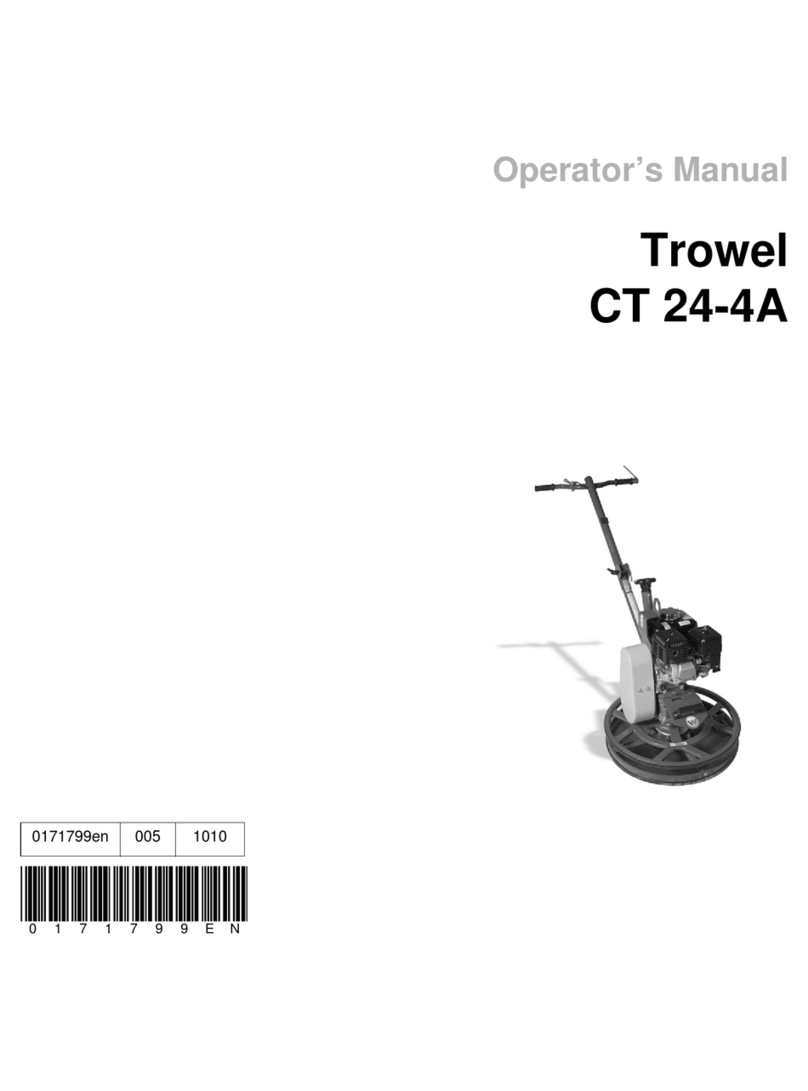
Wacker Neuson
Wacker Neuson Trowel CT 24-4A Operator's manual
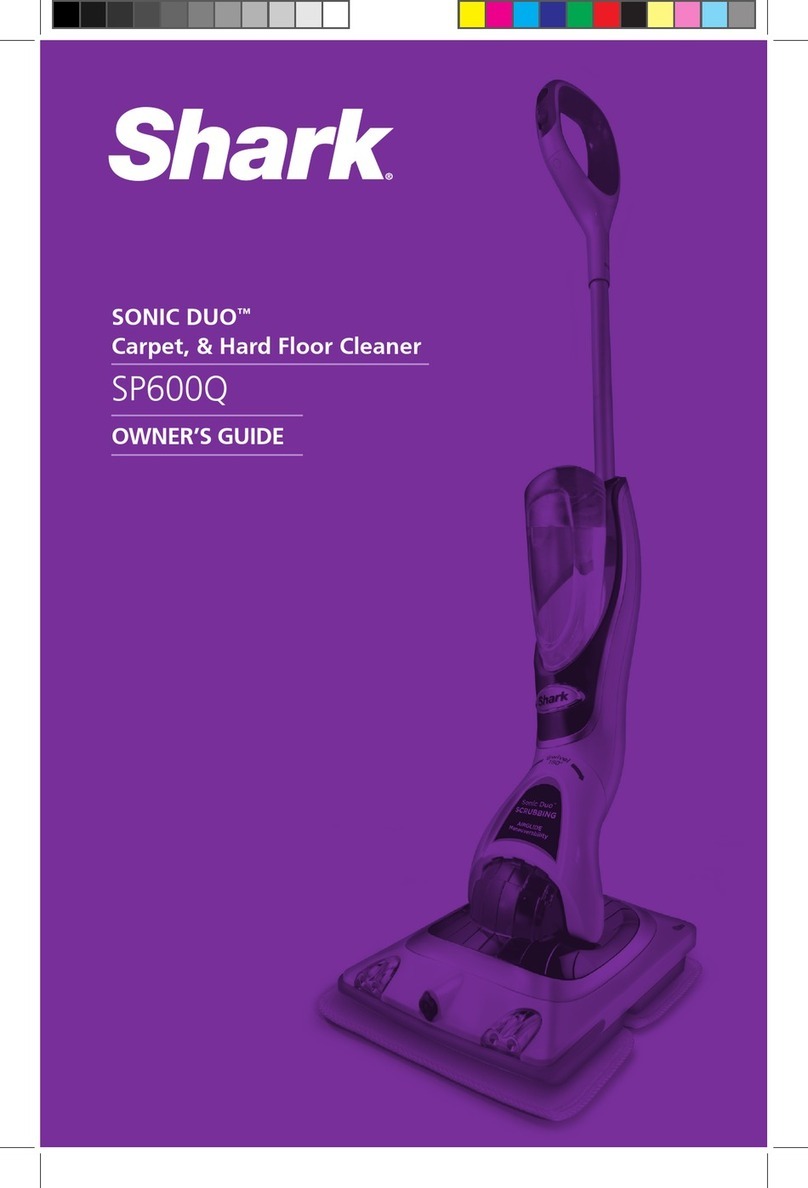
Shark
Shark SONIC DUO SP600Q owner's guide
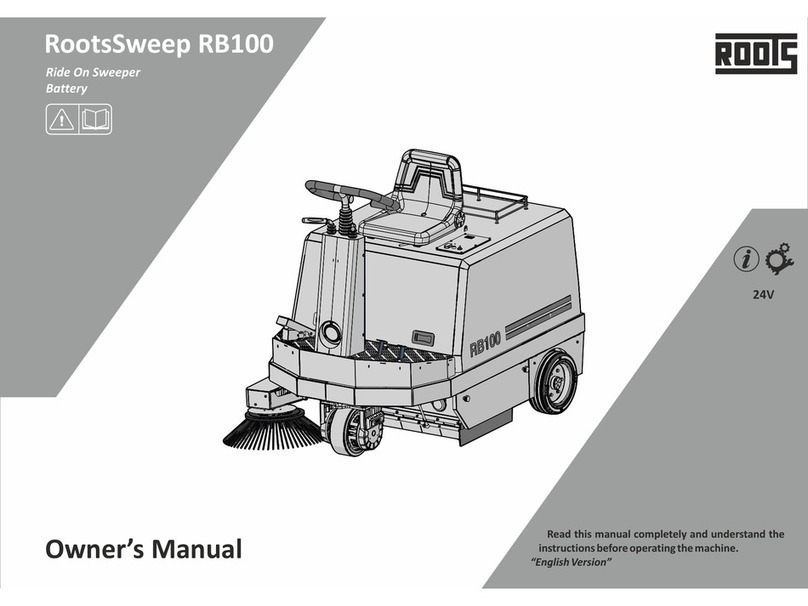
ROOTS
ROOTS RootsSweep RB100 owner's manual

